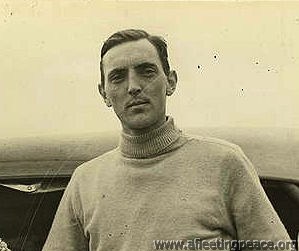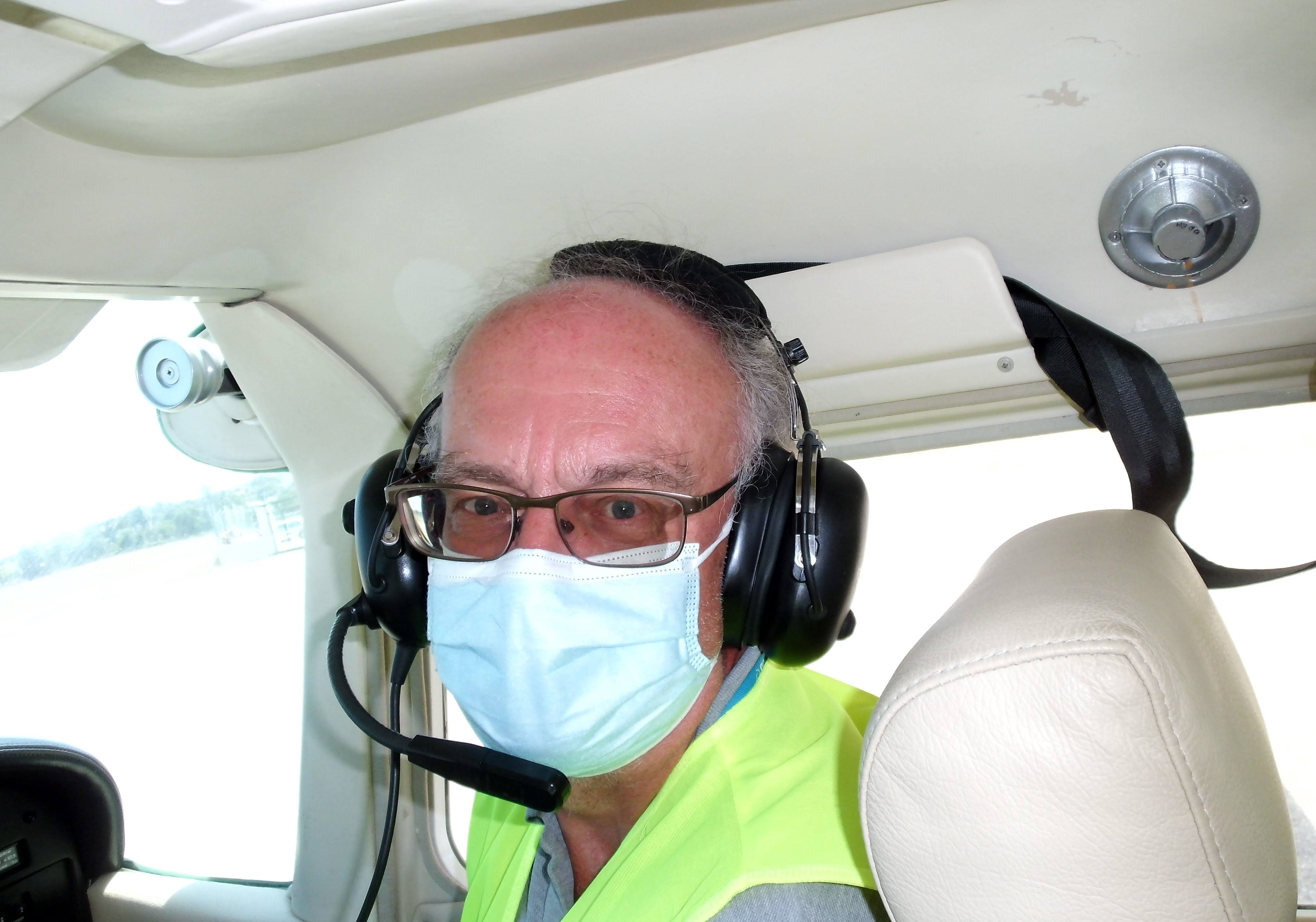|
England-Australia, 1919.—Capt. Ross Smith and Lt. K. M. Smith, with Sergeants W. H. Shiers and J. M. Bennett, on a Vickers "Vimy" biplane (two 350 h.p. Rolls-Royce "Eagle VIII"). Left Hounslow November 12 (9.10 a.m. G.M.T. Arrived Port Darwin December 10 (5 a.m. G.M.T.). Time 4 weeks 2 days. Distance 11,294 miles. |
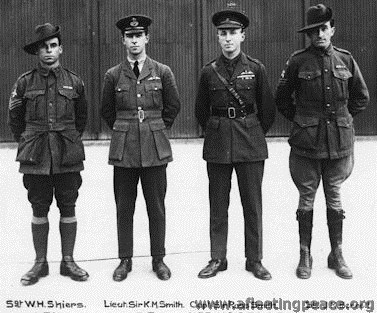 |
|
England-Australia. 1920.—Lt R Parer and Lt. J. Mclntosh on a D.H.9 biplane. Left Hounslow January 9. Arrived Port Darwin August 2. Ray Parer and John Cowie Macintosh persuaded Scottish millionaire distiller Peter Dawson to give them the money for an aeroplane, but only dared ask enough for an F.E.2b (although they would have preferred a DH.9). When Mr Dawson heard this, he scolded them and gave them another cheque. Battling their way through delays, innumerable forced landings and hair-raising exploits, they finally arrived nearly 8 months later, skint and with empty fuel tanks, only the second crew ever to make the journey. They missed out on the £10,000 prize for the first flight in under 30 days, but were given £1,000 as a consolation. |
 |
|
England-Australia, 1926.—Sir Alan Cobham and A. B. Elliott on a D.H.50J biplane seaplane (385 h.p. Armstrong Siddeley "Jaguar"). Left Rochester June 30. Arrived Port Darwin August 5. Time 5 weeks. At Basra Elliott was fatally shot by an Arab. Flight continued with Sgt. Ward, R.A.F. At Darwin wheels were fitted and machine flown to Melbourne and back. |
 |
| <<< | |
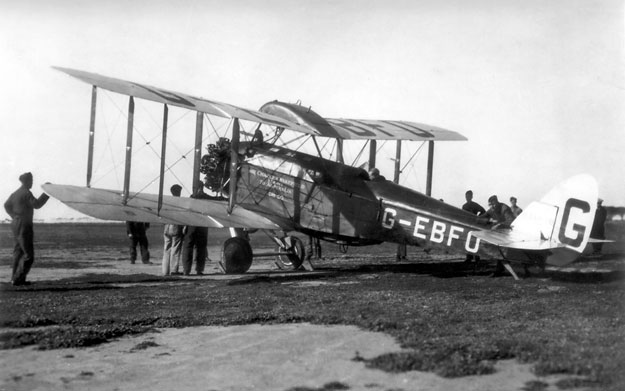 |
Australia-England, 1926 Sir Alan Cobham, Sergt. Ward and C. S. Capel. Return flight. Left Darwin September 4. Arrived Thames, Westminster, October 1. Time 3 weeks 6 days. Total 28,000 miles in 78 days. |
| England-Australia, 1927-28.—Capt. William Newton ('Bill') Lancaster and Mrs. Keith ('Chubbie') Miller, on an Avro "Avian" (32 h.p. "Cirrus ").
Left Croydon October 14. Crashed Muntok, D. East Indies, January 10, 1928. Resumed flight March 12, 1928. Arrived Port Darwin March 19, 1928. Bill Lancaster was killed in April 1933, flying Kingsford Smith's Avian 'Southern Cross Minor' VH-UQG after a forced landing in the Sahara; the aeroplane, and his mummified remains, were only discovered 29 years later. He had kept a diary of the 8 days following the crash. The aircraft remains are now on display in Australia. |
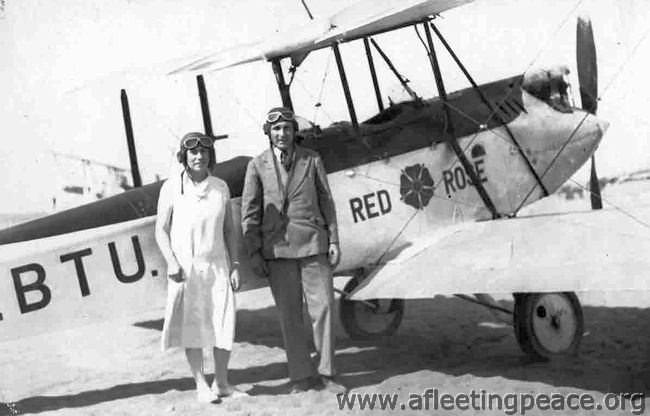 |
| England-Australia (solo), 1928.-—Sqn Ldr Bert Hinkler on an Avro "Avian" (30-80 h.p. "Cirrus").
Left Croydon February 7 (0.48 a.m.). Arrived Port Darwin February 22 (6 a.m.). Time 15 days. Distance 11,000 miles. Record. |
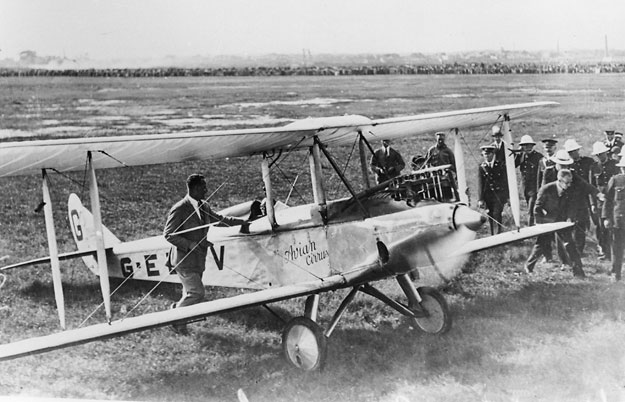 |
|
England-Australia, 1929.—Fit. Lt. S. James Moir and P/O. Harold C. Owen (both RAAF) on G-EBYX, a Vickers " Vellore" (460 h.p. Armstrong- Siddeley "Jaguar"). Left Brooklands March 18. Arrived Cape Don Lighthouse, N. Australia, May 26. Moir and Owen either mistook the Cape Don lighthouse for Port Darwin, or were forced down by engine failure, and landed there in the dark on May 18th with shark-filled seas on one side and crocodile-infested lagoons on the other. They then lived at the lighthouse until they were found on May 26th.
|
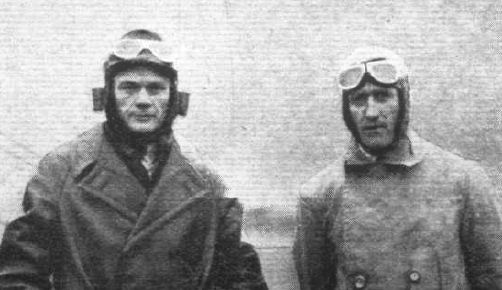 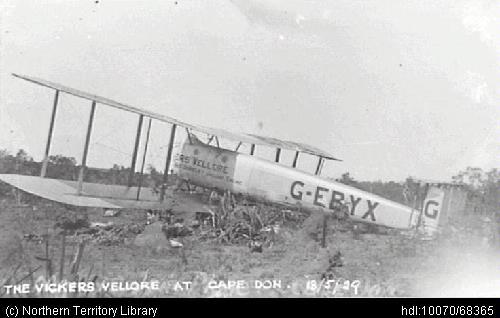 |
|
They had also had a bit of an incident in Egypt on March 23rd, making a forced landing at Mersa Matruh, about 160 miles west of Alexandria. Here is Owen (I think) examining some broken bits, |
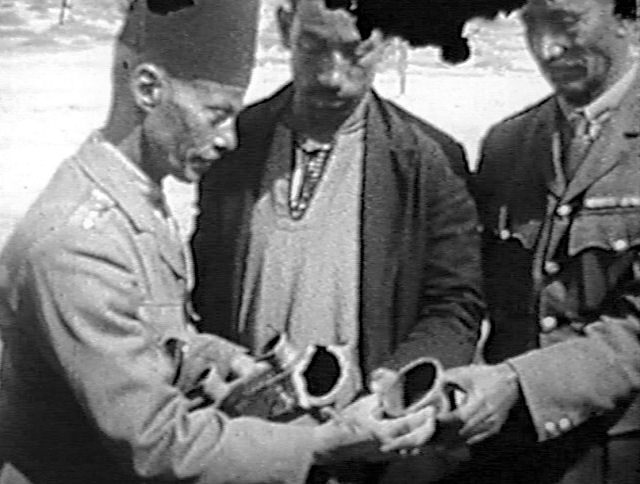 |
| and a view of the machine at a somewhat unconventional attitude. | 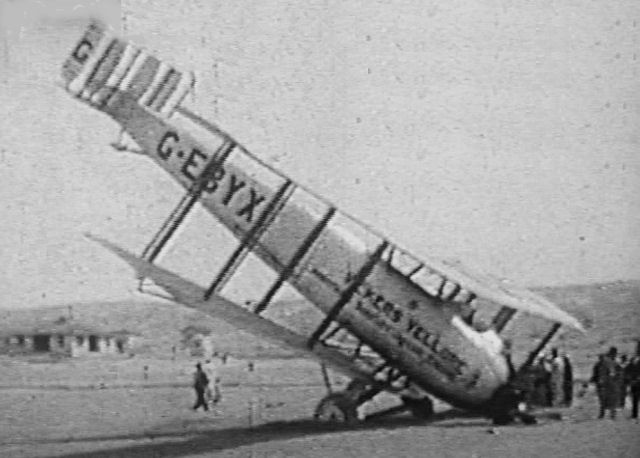 |
| However, "A new wing and undercarriage were sent out to North Africa, and the machine was transported to Cairo. On May 1 it left Cairo." | |
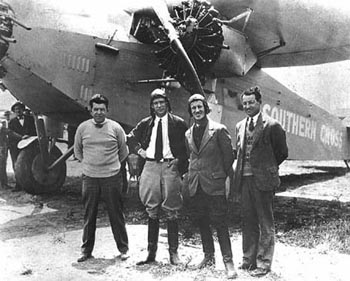 |
Australia-England, 1929.—Sqd. Ldr. C. E. Kingsford-Smith, C. T. P. Ulm, T. McWilliams and H. A. Litchfield, on a Fokker monoplane Southern Cross (three Wright " Whirlwind"). Left Sydney June 25. Arrived Croydon July 10. 12,000 miles in 12 days 14 hr. 18 min.. (Ex. Derby.) Record. |
|
England-Australia (solo), 1929-30 —Francis C. Chichester on a D.H. "Moth" ("Gipsy"). Left Croydon December 20. Arrived Port Darwin January 25 (or 27). Time 5 weeks. The "bespectacled, adventurous, somewhat gauche but determined young man" was suprised by the fame the flight brought him. "I was only trying to achieve a private target which I had set myself" |
 |
|
England-Australia, 1930 —F/O Harold L. Piper and F/O C Kay on a Desoutter monoplane ("Cirrus Hermes"). Left Croydon February 9. Arrived Port Darwin March 23. Time 7 weeks. |
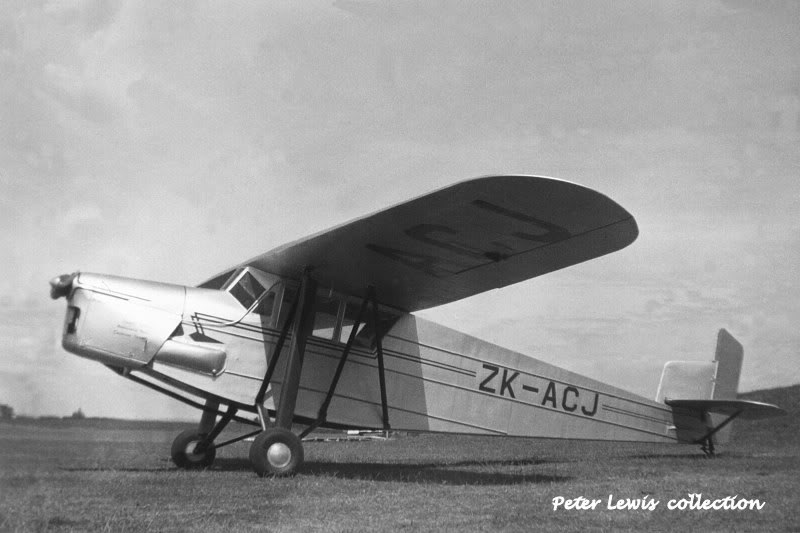 |
| England-Australia (solo), 1930.—Amy Johnson on "Jason", a D.H. "Moth" ("Gipsy").
Left Croydon May 5. Arrived Port Darwin May 24. 9,900 miles in 19 days. Amy's first long-distance flight (she had gained her RAeC certificate only the previous June, and hadn't flown more than 200 miles before this). She bought a second-hand Moth from Wally Hope, painted it green and called it "Jason". She crashed a few times on the way - mostly because her landings were "often atrocious", but became the world's heroine. |
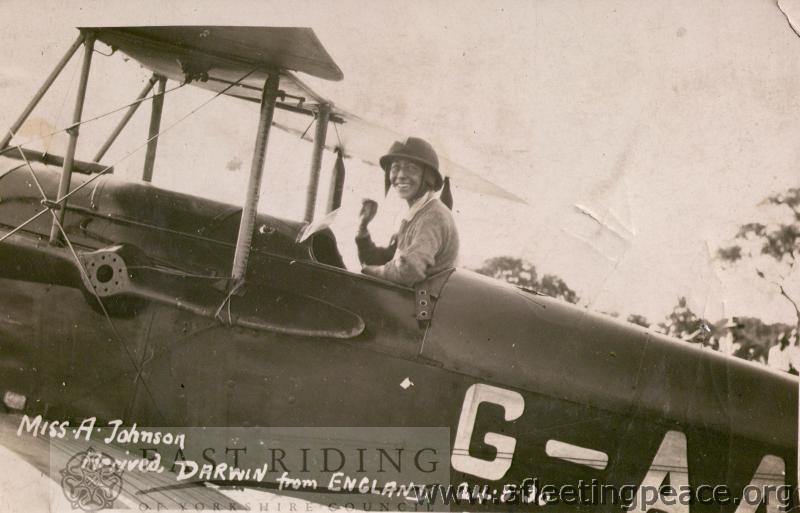 |
|
England-Australia (solo), 1930 —Wing Cmdr C. E. Kingsford-Smith on an Avro "Avian Sports" ("Gipsy II" ) , Southern Cross Junior. Left Heston October 9. Arrived Port Darwin October 19. 10,000 miles in 9 days 21 hr. 40 min. Record. |
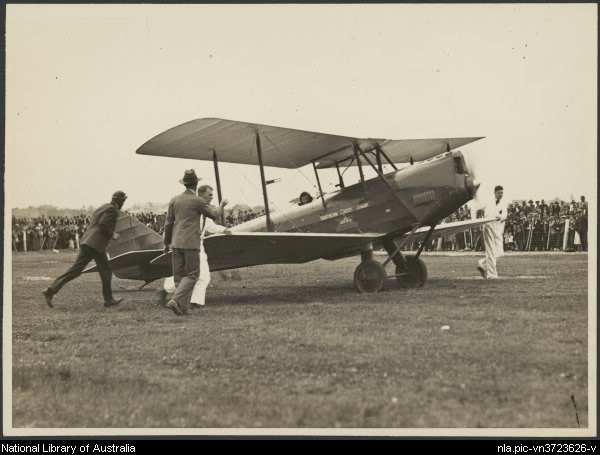 |
|
England-Australia (solo), 1930 Flt Lt Cedrick Waters Hill, from RAF Henlow, on a D.H. "Moth" ("Gipsy"). Left Lympne October 5. Crashed near Atamboea October 17. Resumed flight December 9, reached Port Darwin December 10. Time 7 weeks 5 days. His Gypsy Moth, G-ABEN, was sold in Australia the following March and became VH-UPV; Mrs Lores Bonney then used it to make a solo Australia-England flight 10.4.33-21.6.33. |
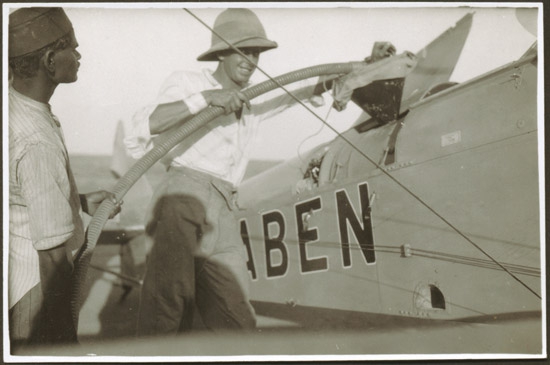 |
|
England- Australia (solo) 1930 —Capt F R Matthews on a D.H. " Puss Moth " ("Gipsy III"). Left Croydon September 16. Arrived Port Darwin October 18. Time 4 weeks 4 days. |
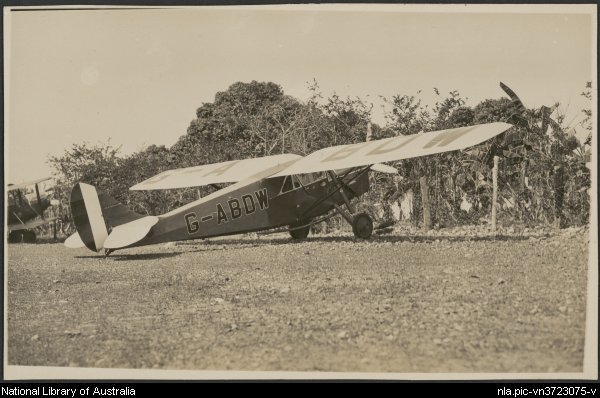 |
|
England-Australia (solo), 1930 —Oscar Garden on a D.H. "Moth" ("Gipsy"), Kia Ora. Left Lympne October 17. Arrived Wyndham November 4. Time 18 days. |
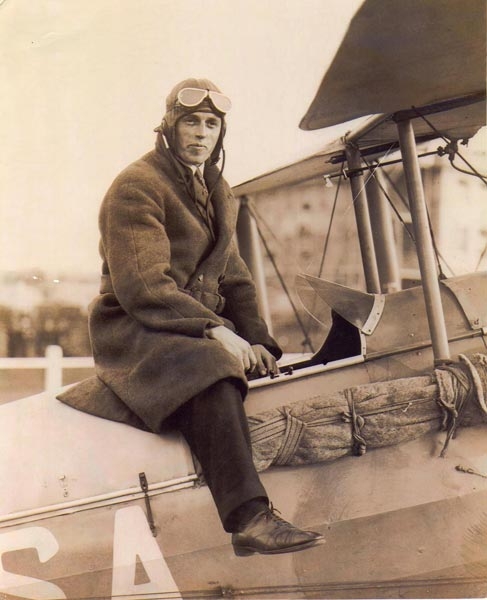 |
|
England-Australia (solo) 1931 G. P. Fairbairn on a Spartan "Arrow" ("Gipsy II”) Left Hanworth February 19. Arrived Port Darwin April 18. "The record is held by Mr. C. W, A. Scott, who overtook Mr. Fairbairn" |
|
England-Australia (solo) 1931 C.W.A. Scott on a DH 'Moth' ('Gypsy II'). Left Lympne April 1. Arrived Port Darwin April 10. 10,500 miles in 9 days 4hr 11 min. Record |
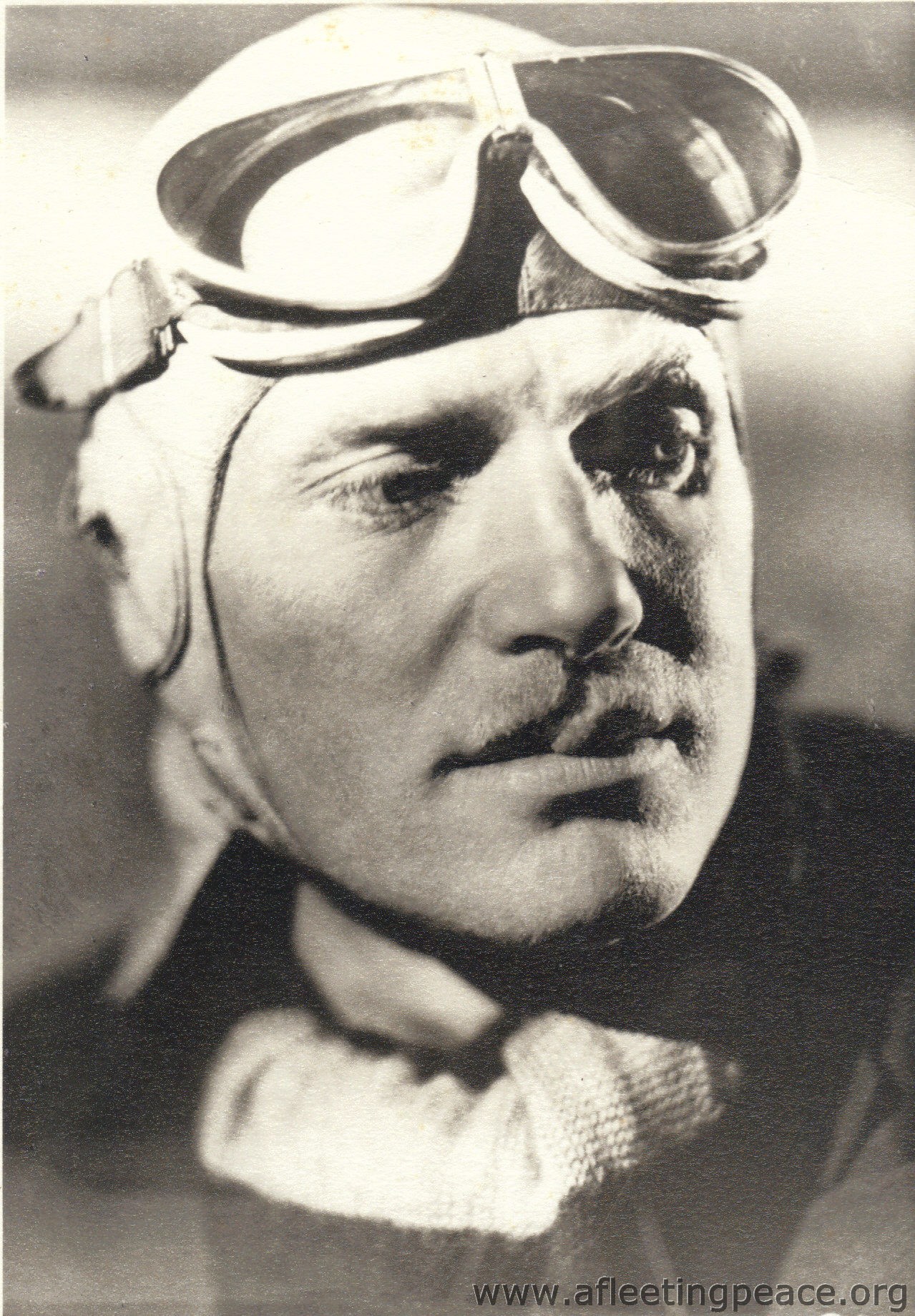 |
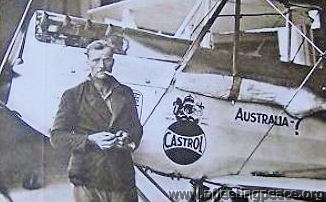 |
Australia-England (solo), 1931 — C.W.A. Scott on a D.H. "Moth" ("Gipsy II"). Left Wyndham May 26. Arrived Lympne June 5. Time 10 days 13 hr. Record |
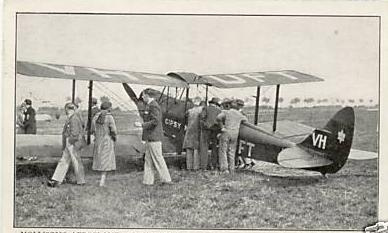 |
Australia-England 1931 - J.A. Mollison on a D.H. Moth. July-August. 8 days 22hr 35min. Record. |
|
England-Australia (solo), 1931 - C A Butler, on a Comper "Swift" (Pobjoy). Left Lympne Oct 31. Arrived Port Darwin Nov 9. 9 days 2hr 29min. Record. |
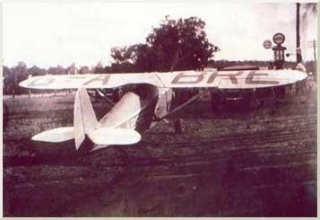 |
| England-Australia, 1932 (solo).-C.W.A. Scott on a D.H. Moth ("Gypsy II"). Left Lympne April 19. Reached Port Darwin April 28. 8 days 20hr 47 min. Record. |
|
England-Australia 1933 (solo).- C.E. Kingsford-Smith on a Percival Gull ("Gipsy Major"). Left Lympne Oct 4. Reached Wyndham Oct 11. 7 days 4hr 44min. Record. |
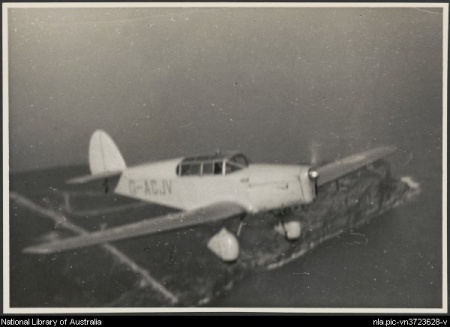 |
|
England-Australia (solo) 1933 -Jean Batten Left Lympne May 9th. Arrived Darwin 24th May 1934. 14 days 23hr 25min. Record. Jean had tried the journey the previous April, but had crashed (twice) near Karachi, the second time writing off the aeroplane. On her second attempt in April 1934, she also had a forced landing near Rome (escaping with a cut lip, and shock), and returned to England. |
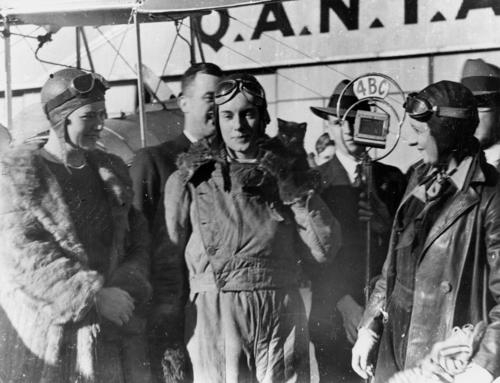 |
|
1933 - C. T. P Ulm, G. Allen, and P. Taylor (Avro " Ten " ) : Harmondsworth to Derby (Australia)
Scotty Allan, Charles Ulm, P.G. Taylor and J.A.W. Edwards in front of Faith in Australia, Avro X monoplane VH-UXX at Heston Aerodrome, England, 25 July 1933 |
 |
 |
Australia-England 1934.-Bernard Rubin and Ken Waller in a D.H. Leopard Moth. April. 8 days 12hr. Record |
|
England-Australia 1934 - C.W.A. Scott and T Campbell Black. MacRobertson Race. Record. |
 |
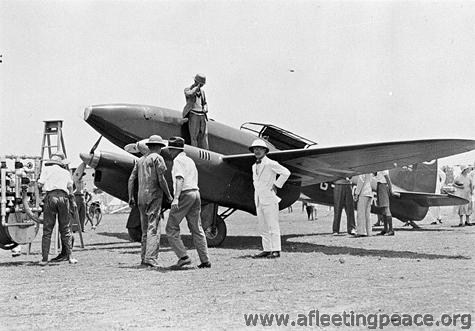 |
Australia-England 1934 - O. Cathcart Jones and K.F.H. Waller. Left Melbourne 09:10 a.m. October 28. Delayed by bad weather in Athens. Arrived Lympne 1:12 p.m. 2 November. 6 days 16hr 10min. Record. Owen said "We have averaged 10 hours flying every day, and covered approximately 2,200 miles a day. We wanted to make this flight back not so much as a speed flight, but as a flight which could be copied for commercial purposes" |
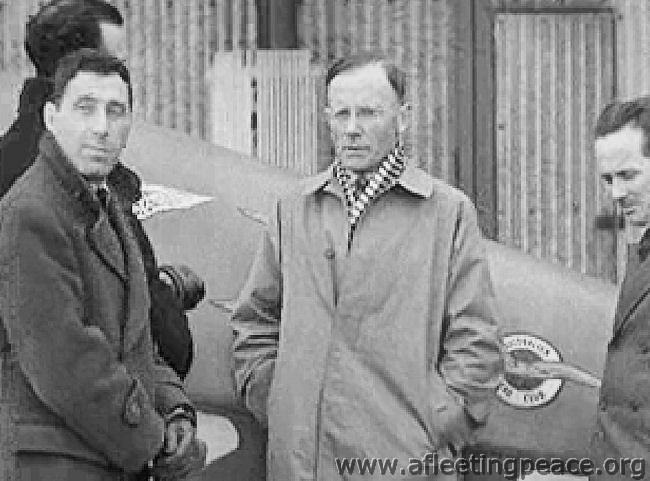 |
Australia-England (solo) 1935- H.L. Brook in a Miles Falcon. March. 7 days 19hr 50min. Record. Harold "I'm not a 38 year old accountant" Brook explains to a less-than-fascinated audience that "Flying to Australia is not the er, terrible thing that um, a lot of people seem to, seem to suppose it is, although it naturally requires a good deal of careful preparation and, erm, or-organisation. This is, this is um, this is the machine I used in, in the air race but unfortunately we didn't um... we didn't um..." [zzzz] |
|
England-Australia 1935 -H F Broadbent. 6 days 21hrs 19min. Record. On 2 November 1935, he took off from Croydon in Percival Gull Six (VH-UVA) in an attempt to break the England to Australia record, which he achieved after arriving at Darwin after 6 days 21 hours 19 minutes. He was awarded the Oswald Watt Gold Medal for 1935 |
|
| Australia-England 1935 (solo).- Jean Batten. April. 17 days 16hr 15min. Record. |
| England-Australia 1936.-Jean Batten. 5 days 21hrs 3min. Record. |
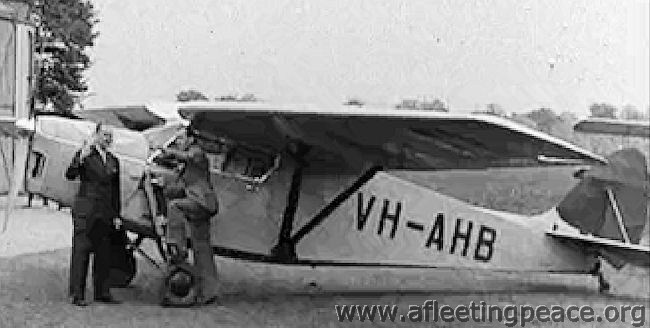 |
Australia-England 1937 (solo) H F 'Jim' Broadbent in a D.H. Leopard Moth. May 6 days 8hrs 25min.Record. |
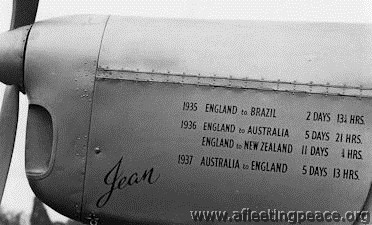 |
Australia-England 1937 (solo).-Jean Batten in a Percival Gull. October. 5 days 13hr 15min. Record. |
The Aviators |
|
Jean Gardner Batten
|
||
|
b. 15 September 1909 in Rotorua, New Zealand, a "shy, determined girl". "By the time I was nineteen I knew my future must be in flying." Studied music from a young age but, having passed the Royal Academy of Music Finals, she sold her beloved piano to get to England and pay for flying lessons. One of the most spectacularly successful aviators of the early 30s; after her solo flight from England to Australia in 1934 (at the third time of trying) the New Zealand Govermnment awarded her £500 in recognition of her feat. She was in Melbourne a few months later to greet Scott and Campbell Black as winners of the MacRobertson Race, and left Sydney the following April to fly back to England, but didn't quite beat her record. In November 1935, came her real breakthrough: she flew to Brazil and beat the South Atlantic crossing record, taking 13 hrs 15min in her Percival Gull. This time, she was awarded:
In October 1936, having attended literally dozens of receptions and award-giving ceremonies, she set off once more, this time to fly to New Zealand in her Percival Gull. On the way, she beat Harry Broadbent's record solo time to Australia, despite a puncture in the tail tyre which a helpful aerodrome official repaired by stuffing it with face sponges. Just as Scott and Guthrie were returning rather sheepishly from the miserable Schlesinger Race to Cape Town, Jean was getting ready to fly from Australia to New Zealand. She arrived there on October 17th, met by large and enthusiastic crowds; the first woman to cross the Tasman Sea, the first direct flight from England to New Zealand. On the last day of 1936, however, Jean's South Atlantic record was beaten by another woman - Mme Maryse Bastié. In 1937, Jean again won the Brittania Trophy, the Harmon Trophy, and the Segrave Trophy for her 1936 flight. In October she set off for England again; at one stage, she was heading west, trying to beat Harry Broadbent's record, as Harry Broadbent was heading east, trying to break her record. She won; Jean beat Harry's record, while he had to give up at Basra. "I confess I am fed up", he said... Jean picked up yet more awards; the Gold Medal of the Royal Aero Club; the Gold Medal of the F.A.I. (no less); summoned to Buckingham Palace to meet the King and Queen of the Belgians (exciting); immortalised in Madame Taussaud waxworks (until they melted her down, at least), another round of receptions as guest of honour... But her brief time in the spotlight was coming to an end. Harry Broadbent took back his Australia-England record; Arthur Clouston and Victor Ricketts more than halved her England-New Zealand record time in 1938. She still attended dinners and receptions in her honour; she wrote her autobiography (called, rather disappointingly, 'My Life'), but she made no more record attempts. Even so, her remaining record, solo to Australia, stood for over 40 years. In WWII she toured the country as part of the 'Wings for Victory' campaign, giving dozens of lectures anywhere between Manchester and Penzance. Her Percival Gull, G-ADPR 'Jean' was presented to the Shuttleworth Trust on 26 April 1961, having been requisitioned by the RAF in WWII and then returned to Hunting Aircraft. However, by 1969 it needed major repairs and was grounded until 1978. Jean herself offered to come back from Tenerife to help: "I used to be quite good at stitching canvas on wings". It was sold in the early 90s (when Shuttleworth was strapped for cash) and is now on display at Aukland Airport:
In 1980 she and Edgar Percival were made liverymen of the Guild of Airline Pilots and Navigators, and she then travelled to Hull to open the 'Silver Wings' exhibition, in honour of Amy Johnson. Jean Batten owned: a 1929 DH.60G Gipsy Moth, G-AALG, which she flew to New Zealand in 1933; a 1929 DH.60M Moth, G-AARB, in which she broke the England-Australia record in 1934, and was later owned by Gabrielle Patterson, R Gordon and BK Lyall (simultaneously, that is), and later, a 1933 DH.60G III Moth Major, G-ACKF. She died in 1982 in Majorca. |
|
Mr Harry F J Broadbent
|
Australian record-breaker (solo round-Australia record in 1931), born 1910. Listed polo, tennis, golf and cricket among his other pastimes. |
|
|
Harold Leslie Brook
|
||
|
b. 11 October 1897, in Bradford Only learnt to fly in 1933, and just scraped up the minimum 100hrs solo flying time required to enter the Race. The aircraft was barely ready in time either; a month before the start it didn't have any seats, and was in "a very unfinished condition". Harold was not impressed by "those fools at Reading [i.e. Miles Aircraft]... this is not the first time they have omitted to do something". In March 1934, he tried to break the England-Australia solo record (held by CWA Scott) but only got as far as the Cevennes before crashing into one of the large mountains they have there. To give him his due, he picked up the important bits of his aeroplane, brought them back and used the engine in this Miles Falcon. In 1935, after taking part in the MacRobertson, he flew back from Australia in record time; you might like to see him talk about his record-breaking flight (on the other hand, you may have some drying paint that needs watching); if so, click Record Flight From Australia - British Pathé (britishpathe.com) Two years later, he added the Cape Town record. Mercifully, there don't appear to be any interviews about this one. Pilot Officer in the Administrative and Special Duties Branch in May 1940, then briefly (28 Oct 1940 - 3 May 1941) in the Air Transport Auxiliary (ATA) And, despite what you may read or hear, was never an accountant in his life (although with his spectacles on, he did rather look like one, and when he talked, he did rather sound like one [sorry]), and he signed himself 'Brook', not 'Brooke'. But 'e were definitely from 'Arrogate.
H. L. BROOK writes to TERRY'S Dear Sirs, I should like to take this opportunity of congratulating you on the excellence of your Springs in my Gipsy 6 Engine. In a record-breaking flight of this description the engine has to be run for long periods in extreme temperatures, and at a higher rate of revolutions than normal, and for a valve spring to break would spell disaster. I had never at any time any fear of this happening with your springs, and they are now at the end of the flight in just as good condition as they were at the start. Yours faithfully, (signed) H. L BROOK. 'Flight' Racing No. 31—H. L. Brook, and —? And speaking of Bradford, here is Harold Leslie Brook, who was born there in 1897, and now resides in Harrogate. He joined the Royal Field Artillery on August 20, 1914, at the age of 16, obtained his commission soon afterwards, and, despite a couple of wounds, served five years in France and India.
Restored to his family, he remained a normal civilian until Yorkshire began to build and fly sailplanes and gliders. These occupations kept him mildly diverted until the approach of his 37th birthday. Then he began to yearn for horse-power. The York County Aviation Club at Sherburn-in-Elmet offered a likely fulfilment of this secret ambition. So, in August, 1933, Brook placed himself in the hands of Instructor Cudemore, and after four hours' instruction became a soloist with serious designs on the MacRobertson Handicap, for which Phillips and Powis have built him the first of their Miles 'Falcons'. What happened between last autumn and this spring is now almost historic. Brook bought the "Puss Moth" (Heart's Content) in which the Mollisons had crossed the Atlantic, and, with a total of 43 hr. in his logbook, pushed off solo from Lympne to survey the route to Melbourne. That was on March 28, 1934, at 5.20 a.m. By noon the incident had closed. Describing it a few days later Brook said that, while flying through very dirty weather over France, he was forced down from 12,000 ft. by ice formation on the wings, and, before he knew how or why, the side of an unsuspected mountain was rushing up at him out of the murk. Guided by some uncanny sixth sense, he brought off a bloodless landing on the mountain proper. The scene of this epic of the air was Genolhac, in the Cevennes. With some local help he salvaged the "Gipsy Major," brought it back to England, and has had it installed in Heart's Content II. Brook's next attempt on the Australian record will not be solo. If expectations are realised, he will be accompanied by two lady passengers. 'Flight' Another England-Australia attempt MR. H. L. BROOKE, a member of the York County Aviation Club, left Lympne at dawn on the morning of Wednesday, March 28, on an attempt to break the record for the England-Australia trip held by Sir Charles Kingsford-Smith with the time of 7 days 3 hours. Mr.Brooke was flying the " Puss Moth " (" Gipsy III ") Heart's Content, in which Mr. J. A. Mollison made an Atlantic crossing. A few hours after leaving Lympne, while flying through fog, he crashed in deep snow near Genholac, in the Cevennes. The machine was completely wrecked, but Mr. Brooke escaped with nothing worse than some bad bruises. For five hours he wandered about inthe mountains, and eventually found a small village, where he was given every attention. Later he returned to the wreck of his machine, and removed the instruments and other articles of value. 'Flight' April 4, 1935 YORK COUNTY AVIATION CLUB, SHADWELL, LEEDS During March the York County Aviation Club, Ltd., flew 63 hours at Sherburn-in-Elmet, and Miss Maurice and Mr.Pilkington made first solos. Two machines flew to Nottingham for the club dance, and Mr. Humble, the honorary instructor, has presented the club with a fire tender—a very apposite gift! The next dance will be held on April 13. Mr. H. L Brook, who has just broken the Australia-England record with a Miles " Falcon," was trained at Sherburn—which appears to be a pretty good advertisement for the instruction. 'Flight' These days, the home of Sherburn Aero Club: http://www.sherburn-aero-club.org.uk/ SWIFTLY from AUSTRALIA How H. L. Brook, in a " Gipsy "-engined Miles "Falcon" broke the Solo Record : His Story in an Interview with " Flight "LAST Sunday afternoon, at 3.55 p.m., the original Miles" Falcon " landed at Lympne, having flown in 7 days•* 19 hr. 50 min. from Darwin, North Australia, withMr. H. L. Brook, of Harrogate, at the controls. The •pilot thus beat the unofficial " s o l o " record of Mr. C. J.Melrose by 13 hr. 10 min., and the officially recognisedperformance of Mr. J. A. Mollison by 1 day 2 hr. 25 min.The shortest time for the Australia-England trip is still,of course, the 6 days 16 hr. 10 min. of Cathcart Jones andWaller in a " C o m e t ."After leaving Darwin at 5.30 a.m. on Sunday, March 24(Australian time), Mr. Brook's time-table was as follows:—Sunday night, arrived Rambang ; Monday, Penang; Tuesday,Rangoon; Wednesday, Calcutta; Thursday, Karachi; Friday,Athens; Saturday, Rome; Sunday, Marseilles (9.25 a.m.) ;Lympne (3.55 p.m.).the Timor crossing, he told a member of the staff of Flight,was " r o t t e n , " with rain, low clouds and heavy head winds.On the trip from Penang he landed on the delta near Calcutta.Over the Sundarbans low clouds and darkness caused him totake this measure rather than to fly on, possibly missingCalcutta, and, as he put it, perhaps making a crash landingthrough shortage of petrol.Perhaps the worst section of the trip was that betweenAthens and Rome, particularly the portion over the channelof Corfu, where a gale was encountered. At Brindisi Mr.Brook was advised not to proceed, but he pushed on andcrossed the Apennines in a snowstorm.And what of the man himself? He is a thirty-eight-yearoldYorkshireman, who, despite the newspaper stories, hasnever been an accountant in his life. When he was youngerhe indulged in motor racing and later built a few sailplanesand gliders. Then he joined the York County Aviation Cluband went solo after four hours' instruction. He next boughtMr. J. A. Mollison's "Puss Moth" Heart's Content, and setout for Australia to survey the route to Melbourne, for he haddecided to enter the MacRobertson Handicap. But ice formationforced the " Puss Moth " down on a mountain side inthe Cevennes. Neither Brook nor the "Major" (which, itshould be remembered, had already been flown over the SouthAtlantic) was rendered hors de combat, however. The enginewas salvaged and Brook brought it back to England, where itwas installed in the first of the Miles " Falcons" which thenwas fitted with extra tanks for the race. During the event itcarried a lady passenger and a large helping of appalling
luck (no connection is suggested between the two facts!).Suffice it to say that the Australian trip, a large portion ofwhich was made in easy stages, took about twenty-six daysDuring his stay "down under," Brook worked until the" F a l c o n " and its engine were in tip-top condition beforestarting his almost unheralded flight.Of travelling in the "Falcon " he says that, compared withflying in an ordinary aeroplane with open cockpits, it was" like travelling in a saloon car instead of on a motor cycle. The veteran "Gipsy Major" was run throughout the flight at 2,100 r.p.m. HILLSON PRAGA Imported specimen 107 Praga E.114 OK-PGC. Regd G-ADXL (CofR 6479) 27.11.35 to F Hills & Son Ltd; dd Speke to Barton 30.12.35. CofV 91 issued wef 27.2.36. Dd 20.4.36 to Harold Leslie Brook; flown by him to South Africa, departing England 6.5.36; arriving Cape Town 22.5.36. Regn cld 6.36 as sold. Regd ZS-AHL 6.36 to OG Davies, Cape Town. Sold 8.37 to H Cooper, Cape Town. Converted to glider at Youngsfield 9.53.
30th Aug. 1940. ADMINISTRATIVE AND SPECIAL DUTIES BRANCH. Harold Leslie BROOKE, D.C.M. (84353). |
|
Lt Owen Cathcart Jones
|
||||||||||||||||||||||||||||||||||||||||||||||||||
Born 5th June, 1900, London (definitely not Canadian, despite some nasty rumours).
|
||||||||||||||||||||||||||||||||||||||||||||||||||
|
Mr (Sir) Alan John Cobham KBE AFC
|
||
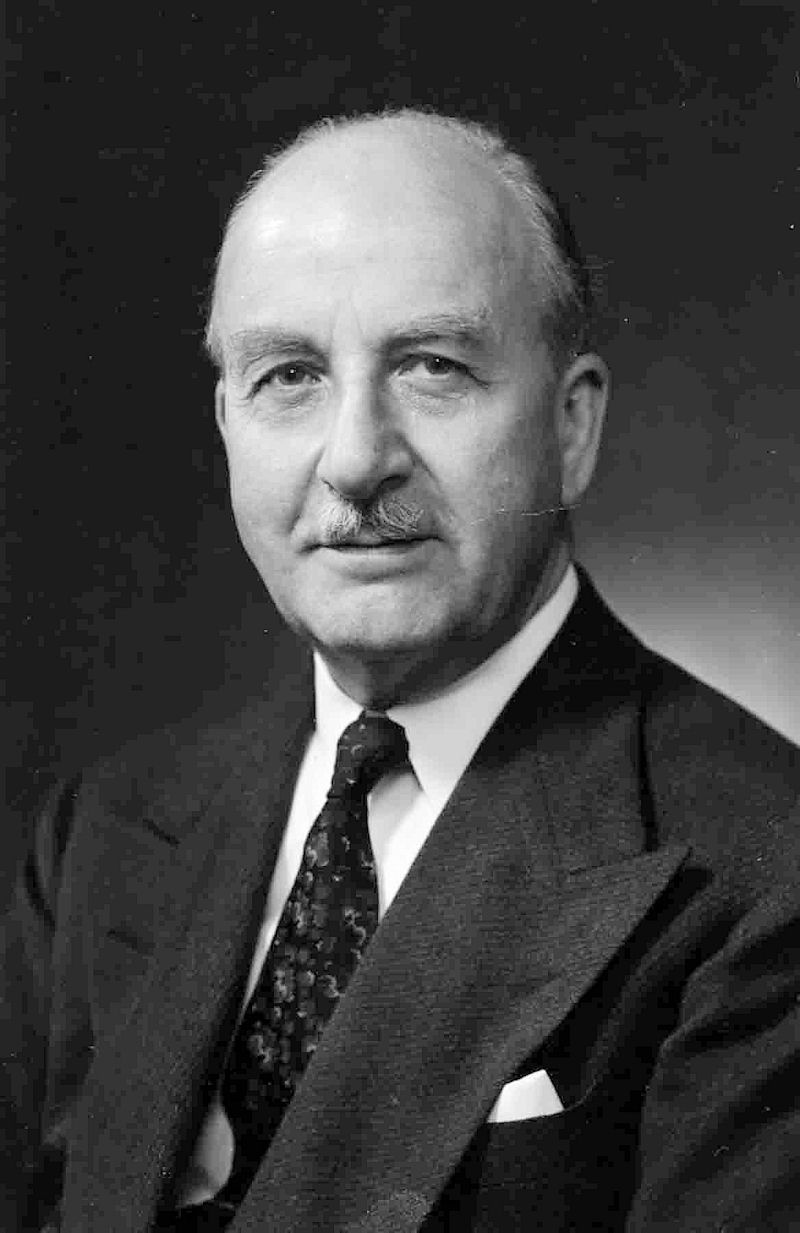 |
| Mr George Patrick Fairbairn | ||
|
|
||
|
He made an attempt in 1931 to set a record for the flight to Australia: "AIRMAN’S AMBITION. To Break Flight to Australia Record. The Australian airman Mr. G. P. Fairbairn, who arrived at Lyons aerodrome yesterday evening in his light aeroplane, has had to postpone his departure this morning owing to unfavourable weather. As soon conditions improve, he will take off for Italy. Mr Fairbairn made a short stop at Le Bourget yesterday before going on to Lyons. Mr. G. P. Fairbairn. who is a Cambridge graduate and the nephew of Mr. “Steve” Fairbairn, the famous rowing coach, learned to fly at the University. Last autumn, with a Cambridge friend named Shenstone, he left on a flight to Kenya, which had to be abandoned owing to mishaps in Italy and Egypt. Mr. Fairbairn’s route on this occasion will be via Marseilles, Catania, Tunis, Benghazi, Cairo, Bagdad, Task, Karachi, Calcutta, Rangoon, Victoria Point, Singapore, and Batavia to Port Darwin." - Hartlepool Northern Daily Mail - Friday 20 February
However, it eventually took him nearly two months to get there: "AUSTRALIAN FLIGHT Mr. Fairbairn Reaches Port Darwin PORT DARWIN. . Mr. G. P. Fairbairn. the Australian airman who set out from Hanworth aerodrome, England. February 19 to beat Wing Commander Kingsford-Smith’s record under ten days for a light aeroplane flight between England and Australia, arrived here at. 3.27 this afternoon. The record is held by Mr. C. W, A. Scott, who overtook Mr. Fairbairn and completed the flight in 9 days, 4 hours. 11 minutes." - Portsmouth Evening News - Saturday 18 April 1931 'Flight' obviously lost interest: "G. P. Fairbairn on a Spartan "Arrow" ("Gipsy II”). Left Hanworth February 19. Reached Nice February 20. Flight abandoned." Flight, October 30 1934
m. 1933 Mary Robertson [Murray] 1 daughter b. 1934
d. 26 May 1935 "PLANE NOSE DIVES INTO ROAD - Cambridge Pilot and Wife Killed MELBOURNE, Sunday. G. P. Fairbairn, former Cambridge man, and his wife, formerly Miss Mary Murray, Melbourne, were killed to-day when their ’plane crashed on a road near Essendon Aerodrome. The machine was the same as that in which Mr. Fairbairn flew from England to Australia in 1931 in company with Mr. K. Shenstone[sic]. Mrs. Fairbairn was in the pilot’s seat at the time of the tragedy. Apparently the engine stalled and the ’plane went into a spin, nose diving to the road. A motor-lorry passing at the time was grazed by one of the wings. Mr. Fairbairn was one of the first Cambridge undergraduates to own his own ’plane and was a keen member of the University Squadron. While they were at the University together in 1930, Mr. Fairbairn and Mr. Kenneth Shenstone set out to fly to Kenya and back, but they crashed in landing at Heliopolis on the outward journey, and they abandoned the flight. In the spring of 1931 they [sic] attempted to break Sir Charles Kingsford-Smith’s record of under ten days for a flight from England to Australia. They [sic] completed the journey, but took 57 days, and were overtaken on the way by Mr. C. W. A. Scott, who set up a record of 9 days 3 hours [sic]." - Belfast News-Letter - Monday 27 May 1935
Obviously there are conflicting reports as to whether George was accompanied on his Australia flight by Kenneth Shenstone!
see also Obituary - George Patrick Fairbairn - Obituaries Australia (anu.edu.au)
"THE FAIRBAIRN ESTATE Melbourne, Sept. 23, 1935. Estate valued at more than £91,639 was left by the late George Patrick Fairbairn, grazier, of Wooloomanta station, Lara, who, with his wife, was killed in an aeroplane crash earlier in the year. The late Mr. Fairbairn bequeathed Wooloomanta to the first of his sons who should attain the age of 25 years, but, as he had no son, the station is left to his nephew, George Michael Wheatley. The residue of the estate was left to his wife, but, as she was killed at the same time as her husband, it is now left to Fairbairn's infant daughter, Mary Frances Fairbairn, aged 21 months."
|
||
| Sqn Ldr Herbert John Louis Hinkler | ||
|
photo: 1927, aged 35 |
|
|
|
Australian 'Lone Eagle', aviation pioneer, killed in a crash in Italy in 1933 |
||
|
Amy Johnson (Amy Mollison) Royal Aero Club Certificate 8662 (28 Jun 1929) |
||
|
|
1934 |
|
|
Amy Johnson, Hull's Finest a.k.a. Amy Mollison Born 1st July 1903 in Kingston upon Hull; Amy was 'a slight young woman with heavily lidded eyes, dentured teeth, a shy smile and a soft Yorkshire accent' [she later developed a rather fake upper-class BBC one, possibly under her husband Jim's influence]. By 1929, a secretary (albeit one with an economics degree, and an engineer's licence to go with her aviator's certificate) turned solo record-breaking pilot and all-round nation's sweetheart. Married for six years to Jim Mollison (which was a Big Mistake). On May 26th, 1932, after her solo flight from America, Amelia Earhart was the guest of the Royal Aero Club in London, and amongst the ladies in attendance were Lady Bailey, Amy, and Winifred Spooner (less than a year before her untimely death). 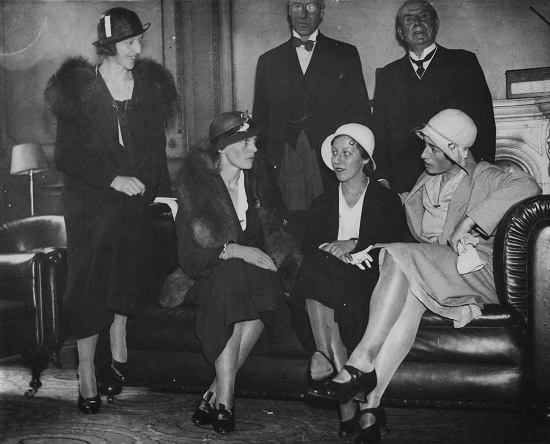 Air Transport Auxiliary in WWII (Died in Service) Amy's aircraft included: a 1928 DH.60G Gipsy Moth (G-AAAH) which she named 'Jason', and is now in the Science Museum; a 1930 DH.80A Puss Moth, G-AAZV, 'Jason II'; a 1930 DH.60G Gipsy Moth, G-ABDV, er, 'Jason III'. After 1930 she owned: a 1932 DH.60G III Moth Major, G-ABVW, ... ummm, let me guess... yes... 'Jason 4', and a 1932 DH.80A Puss Moth, G-ACAB, 'The Desert Cloud'. |
||
| Air Vice Marshal Cyril Eyton Kay CB, CBE, DFC, RNZAF | ||
|
|
|
|
|
Distinguished Flying Cross in June 1940: "This officer was captain of an aircraft ordered to attack important targets in the forests south of Bourlers and Baileux during a night in June. In spite of extremely difficult conditions, and in the face of severe opposition, he successfully bombed the objective, starting several fires which gave accurate direction to other aircraft of this sortie. He then descended to a low altitude and, again in the face of heavy opposition, attacked the woods with all his machine guns. Sqn. Ldr. Kay has conducted a number of operations in recent weeks and has shown daring, determination and outstanding ability." Cyril Eyton Kay, Hewett's co-pilot, is also his fellow citizen. He was born at Auckland on June 25, 1902. In 1925 he obtained a Short-Service commission (F/O.) in the R.A.F., and was sent from England to Egypt, where he promptly developed enteric and was invalided back after three months in hospital. Between 1926 and 1929 he was with No. 5 F.T.S. (Sealand), No. 2 Squadron (Manston), and, as navigation officer, with No. 26 at Catterick, after a course at Calshot. In 1929, with F/O. Harold Piper, Kay obtained special leave and flew from London to Sydney in a Desoutter I monoplane. The flight was interrupted for three weeks by a forced landing on the island of Western Baronga, off Burma. Returning to England in 1930, Kay took an Instructor's course at the C.F.S. (Wittering), and was posted, until the end of 1931, as instructor to No. 2 F.T.S. (Digby). He then left the Service, but remained in England until the end of 1932 as demonstration pilot with a commercial company. In 1931 he visited the Wasserkuppe and achieved the distinction of being the first Britisher to secure the "C" gliding certificate. During the last two years he has continued civil flying in New Zealand. Both he and Hewett are married. Delivery of the "Dragon Six" now being built... Kay, who has held a short-term commission with the Royal Air Force, flew from England to Australia with a brother Flying Officer, Piper, in a Desoutter, in 1930. He is one of the very few men in Australia who holds a second class Air Navigator's Certificate. ABCs Guide, 1934 d. 29 Apr 1993 in London, aged 90 |
||
| Capt F R Matthews | ||
|
|
|
|
| ?? | ||
| Lt John Cowie McIntosh | ||
|
|
|
|
|
Co-pilot with Ray Parer in the England-Australia Race 1919 Killed shortly afterwards, sadly: "It is with the utmost regret we have to record the death, through an aeroplane accident in Australia, of Lieut J. McIntosh, who with Lieut. R. J. Parer, made that exceedingly plucky and sporting flight from England to Australia last year. It appears that Lieut. McIntosh, while making a cross-country flight, accompanied by his mechanic and a passenger, experienced engine trouble near Pithara (300 miles from Perth), and crashed after a nose-dive from about 2,000 ft. The mechanic also was killed, and the passenger injured." Neil Follett kindly contacted me to clarify this, thus: "He was flying an Avro 504, which crashed on take-off from Pithara where he was conducting joy flights. I think 200 feet would be more appropriate than the 2000 feet mentioned. Pithara is about 200 kms (120 miles) from Perth, as the crow flies." |
||
| Jessie Maud Miller | ||
|
|
|
|
|
'Chubbie' Miller (Mrs Keith Miller), the first woman to complete an England to Australia flight d. 16 December 1972 in London |
||
| James Allan Mollison MBE | ||
|
|
with Amy and Sir Alan Cobham in 1932 or 33 |
|
|
RAF commission in 1923, transferred to reserve 1928, then a lifeguard and air-mail pilot in Australia. Made many record flights; his philosophy seems to have been "...one cannot be young for long, and it has always been my practice to live for the moment." He and Amy were married in July 1932, but They Said it wouldn't last, and it didn't; Jim had to fly Black Magic back by himself after the Race; Amy went on KLM. Jim joined the Air Transport Authority (ATA) early in WWII, and carried on right through until 1946, ferrying more than 1,000 aircraft, comprising nearly every type used by the RAF - he was a 'Class V' pilot (authorised to fly any type of aircraft without previous instruction). He reckoned he had "on a conservative estimate, successfully delivered not less than 15 million pounds' worth of aircraft." - see https://www.ata-ferry-pilots.org/index.php/category-blog-1940/275-mollison-james-allan
Jim re-married and divorced twice, continued drinking [he once said that, when he was cold, tired and frightened, he recommended "brandy, lots of it"] and ended up as the owner of a hotel in Surbiton, bought for him by his third wife Mary [Kampuis], on the strict understanding that it would never be licensed to sell alcohol.
Died 30th October 1959 in Surbiton, London, aged 54, from alcoholic epilepsy.
Educated: Glasgow and Edinburgh Academies
Commissioned RAF 1923, transferred to reserve 1928, subsequently air-mail pilot in Australia
Record flights:
Australia-England. July/Aug 1931. 8 days 19hrs 28min
England-Cape (first flight by West coast Route) Mar 1932 - 4 days 17hrs 5min
First solo Westward North Atlantic flight. August 1932
First solo westward south Atlantic flight, and first flight England-South America, February 1933
First flight England to USA (with Amy Johnson) July 1933
England to India (with Amy Johnson) October 1934. 22 hours
New York-Newfoundland-London (North Atlantic record crossing coast-to-coast 9 hours 20min) October 1936
England-Cape by eastern route, November 1936. 3 days 6hrs.
Joined ATA early in war. Released in 1946, after ferrying more than 1,000 aircraft, comprising nearly every type used by RAF - single, twin and multi-engined)
Rank: Flight Captain
Category as pilot: Class V (authorised to fly any type of aircraft without previous instruction)
Ferried aircraft all parts of England, Scotland, North Ireland, France, Belgium, Holland.
On conservative estimate successfully delivered not less than £15,000,000 of aircraft.
For his war-time service in the ATA, Mr Mollison was awarded the M.B.E.
|
||
|
Raymond John Paul Parer
|
||
|
Joined the RFC during WWI, but a medical officer had insisted that Ray's heart 'was not strong' and he wasn't allowed to fly above 10,000 ft. The only person to compete in the Air Races from England to Australia in both 1919 and 1934. For the 1919 Race, he and John Cowie Macintosh persuaded Scottish millionaire distiller Peter Dawson to give them the money for an aeroplane, but only dared ask enough for an F.E.2b (although they would have preferred a DH.9). When Mr Dawson heard this, he scolded them and gave them another cheque. Battling their way through delays, innumerable forced landings and hair-raising exploits, they finally arrived nearly 8 months later, skint and with empty fuel tanks, only the second crew ever to make the journey. In 1927, when the New Guinea Gold Rush began, he shipped a DH.4 there and set up the Bulolo Goldfields Aeroplane Service. Tried to enlist in the RAAF in 1941, but was deemed too old and joined the Merchant Navy instead. He was 'by nature shy and retiring' but clearly, never gave up - hence his nickname 'Battling'. Spent the last 20 years of his life farming near Brisbane, and died there 5th July 1967, aged 73. |
| Mr Charles Edward Murray Pickthorn | ||
|
|
|
|
|
a 'Dealer' from London; WWI ace (5 victories, one shared with James Robb). Attempted an England-Australia flight in 1930 with F/O. C. J. Chabot on a D.H. "Puss Moth"; left Croydon October 6, but abandoned the flight in Karachi on October 13. died 1938 |
||
| Mr Harold Lord 'Pip' Piper | ||
|
photo: 1918, aged 20 |
photo: 1937, aged 39 |
|
|
Originally from New Zealand, a farmer. He and Cyril Kay flew a Desoutter from England to Australia in 1930; later chief test pilot for Shorts, until 1948. "Apart from flying, Pip's other passions in life are duck shooting, guns and boats."
d. 1965 |
||
| Mr Charles William Anderson Scott | ||
|
photo: 1934, aged 31 |
|
|
|
Born 13thFebruary 1903 in London One of the truly great aviators of the 1930s, establishing many long-distance records and winning some of the most important long-distance races of the period, but rather went to seed after that and shot himself after WWII. Scott wrote a book, and enterprisingly called it 'Scott's Book'. "Scott is a splendidly-built six-footer, always in excellent condition. His other sporting recreations are golf and sailing." "Charles Wiliam Anderson Scott, aviation editor of the 'News Chronicle', is the elder son of Mr Charles Kennedy Scott, the musician and conductor. Educated at Westminster School, the future airman began his career as a sugar planter in Demerara, South America. The experience did not prove at all to his liking and he returned to England in 1922. Sailing was his passionate hobby - it still is - but as a youth trying to find his rightful career, flying did not occur to him until a friend suggested joining the Royal Air Force. Young Charles Scott sent in his application and thought little more about it until he found himself accepted and ordered to report to the Flying School at Duxford. The Royal Air Force occupied the next four years of his life [he was heavyweight and light-heavyweight boxing champion whilst in the RAF] and in 1926 he was again wondering what was the next move when chance played the deciding game again. A sharp shower of rain sent him scurrying into Australia House for shelter with the result that he was bound for Australia not many weeks later. There Scott became a pilot with Qantas Ltd., flying the mail routes in Western Queensland and acting as a flying instructor from 1927 to 1930. During that period he met the late Bert Hinkler, Mrs Mollison and the late Sir Charles Kingsford Smith and was inspired to break records. Scott resigned his flying job in Queensland and came to England in 1931 determined to break the England-Australia record, despite accumulating financial troubles caused by the rising Australian rate of exchange. He got there, reducing the record to 9 days 3 hours. That year he flew back again and made another record of 10 days 23 hours. Both flights beat Sir Charles Kingsford Smith's times. In 1932 he attacked the England-Australia record for the second time and regained it with 8 days 20 hours. The greatest adventure of his career was the magnificent flight in the Mildenhall-Melbourne air race of 1934 when he and the late Tom Campbell Black reached Melbourne in just under 3 days.
On September 17, Scott was married to Miss Greta Bremner, younger daughter of Mr and Mrs E L Bremner, of Melbourne, Victoria, Australia, only 12 days before the start of the Johannesburg air race." - from the Celebration Dinner programme after the race (October 14th 1936 at Claridge's Hotel).
In 1936, his "Flying for All" Display embraced over 150 centres in the United Kingdom and Irish Free State, and was aimed particularly at "familiarising people with some of the cheap, easy-to-fly light aeroplanes available to-day". Died 15th April 1946, in Germany, aged 43
p.s. The £10,000 MacRobertson first prize would, using average earnings, be worth about £2 million today. |
||
| Lt Keith Macpherson Smith | ||
|
|
© The Royal Aero Club [0738-0021] |
|
| Keith Macpherson Smith - Wikipedia | ||
| Capt Ross Macpherson Smith | ||
|
|
|
|
| Ross Macpherson Smith - Wikipedia | ||
| Mr Kenneth Herbert Fraser 'Ken' Waller | ||
|
|
|
|
|
b. 7 April 1908, in Lambeth, London As you can see, he was over 6ft 4in in height. Despite this, learnt to fly in Kent, got his aviator's certificate in 1930 and then became an instructor at Brooklands in Surrey. Pilot, with Owen Cathcart Jones, of one of the D.H. Comets for the MacRobertson Race in 1934; given third prize (erroneously, in my view, but it's probably a bit late to say that now). In 1935, got annoyed with Owen Cathcart Jones for something he said in his book that Ken felt "reflected on his courage and ability as a pilot", and even went to court over it. Owen replied that "that was the last thing he intended, as Mr. Waller and he had been, and still were, very good friends", which seemed to settle the matter. He and Max Findlay competed in the Schlesinger Race to South Africa in 1936, in an Airspeed Envoy (No 13), but this crashed on take-off in Northern Rhodesia, killing Findlay and the radio operator; Ken was thrown out through a hole in the fuselage and badly hurt. After WWII, became Miles Aircraft's chief test pilot (he delivered a Hillman Minx car to Orkney in 1948 at a cost of £35, you may remember). |
||

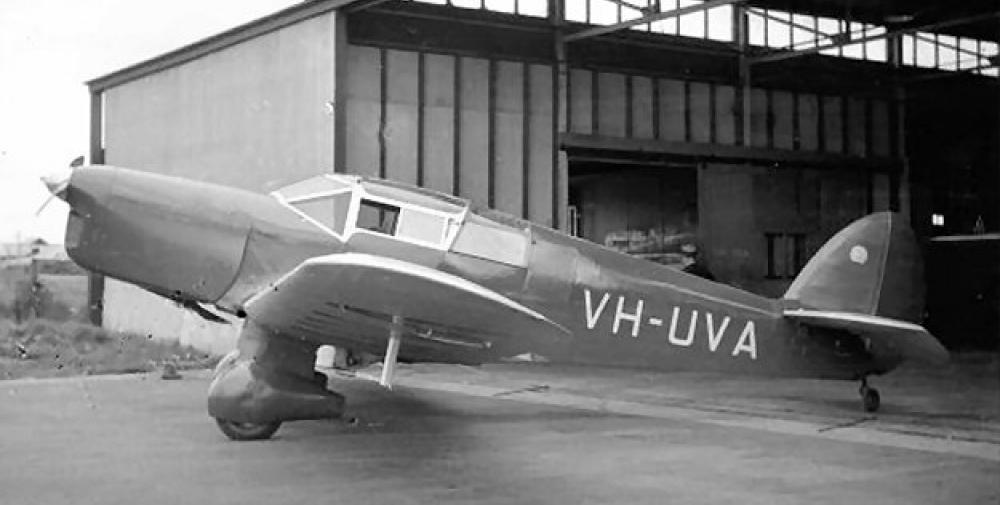

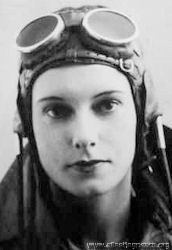 in 1930
in 1930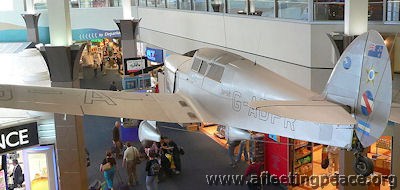
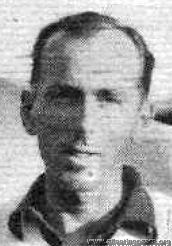 photo: 1937, aged 27
photo: 1937, aged 27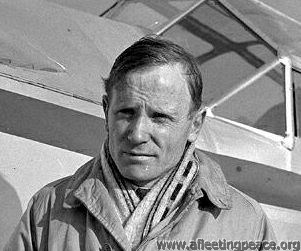
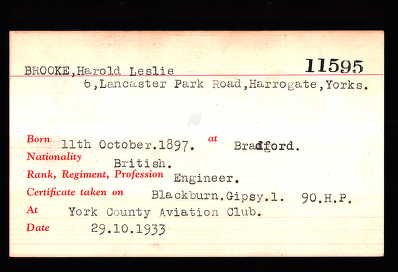
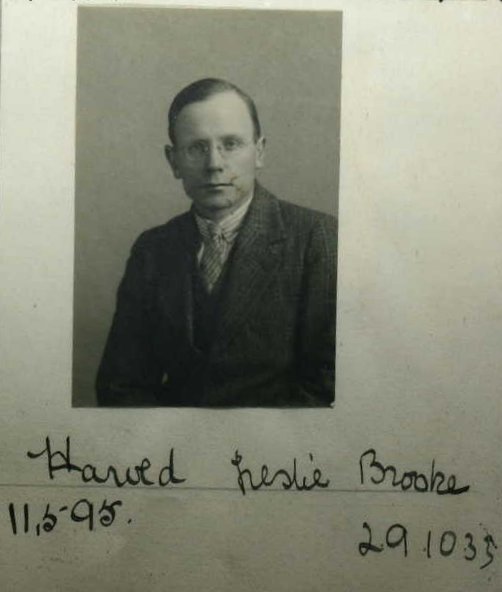
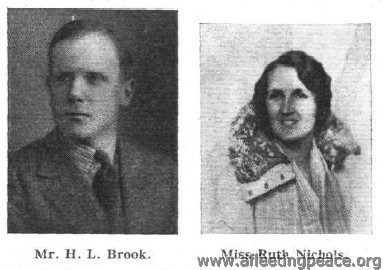
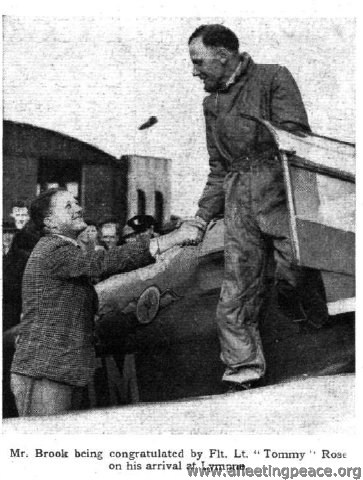
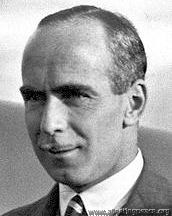 photo: 1934
photo: 1934
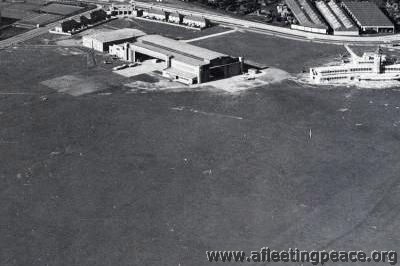
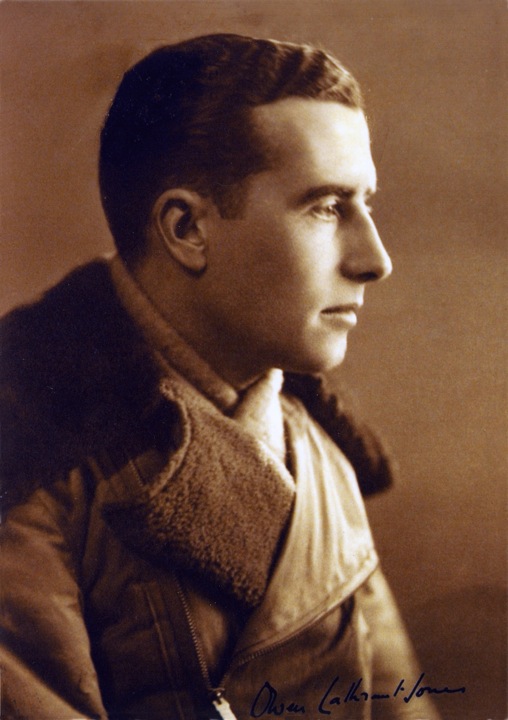
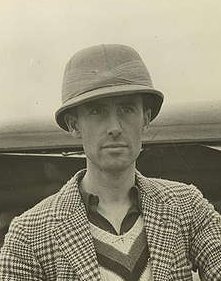 1934
1934 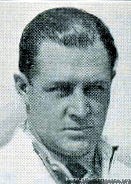
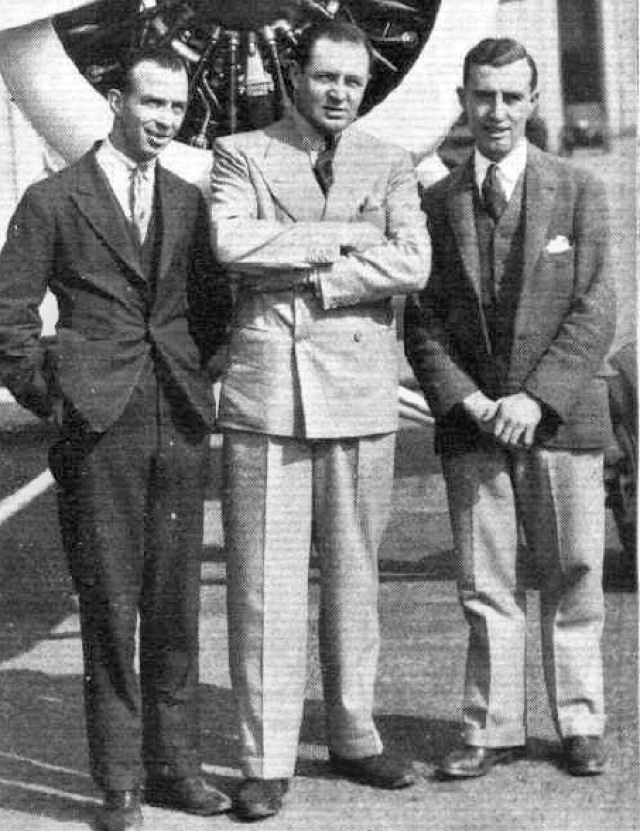
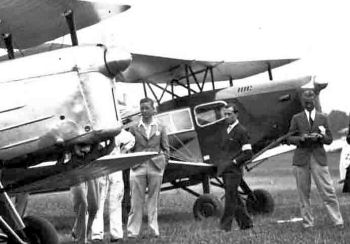
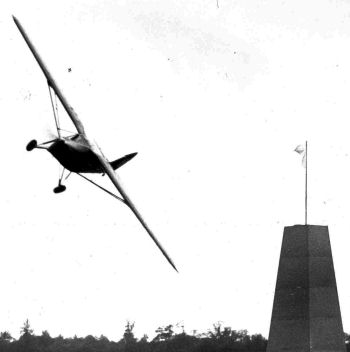
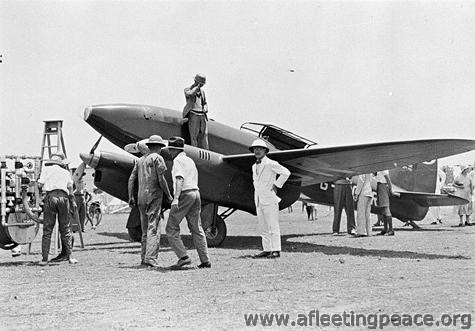
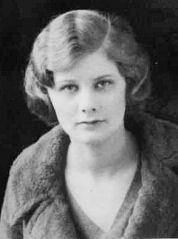
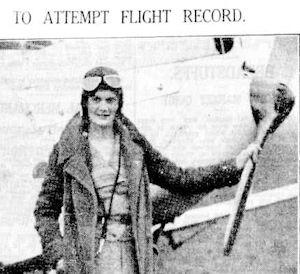
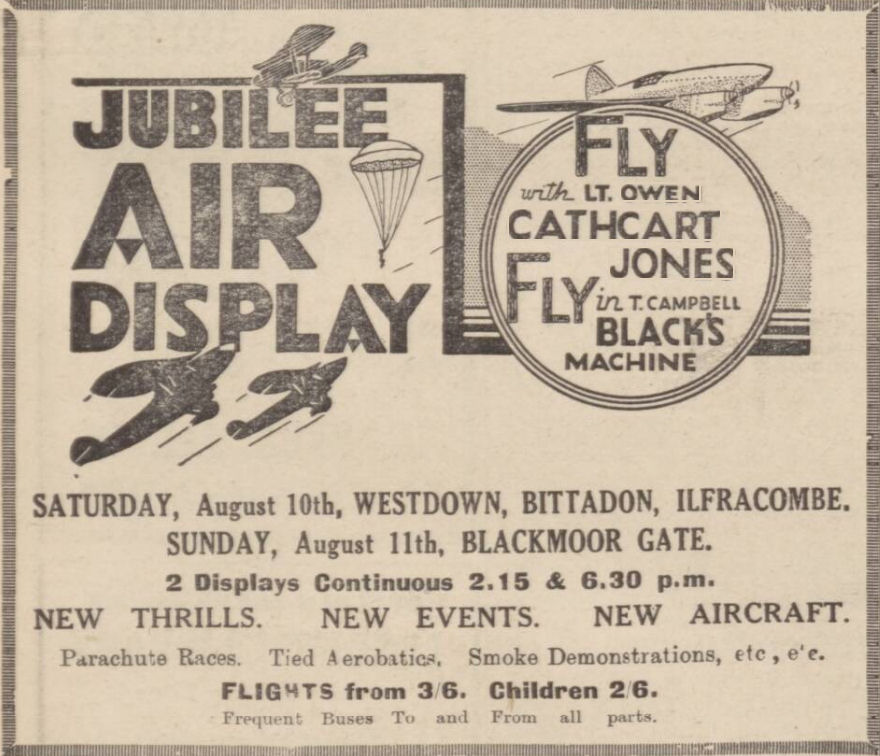
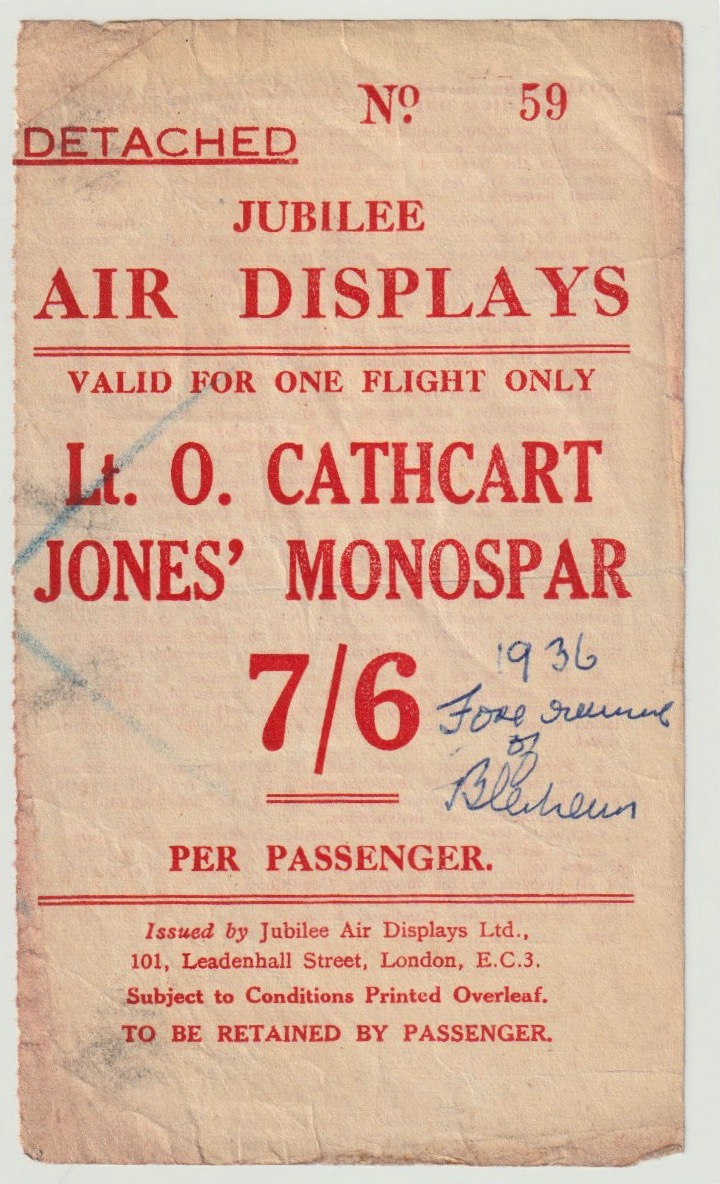 via Joss Mullinger
via Joss Mullinger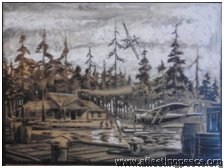
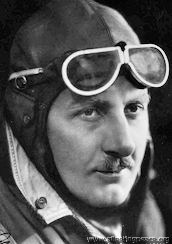 in c.1934, aged c.40
in c.1934, aged c.40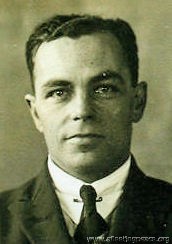
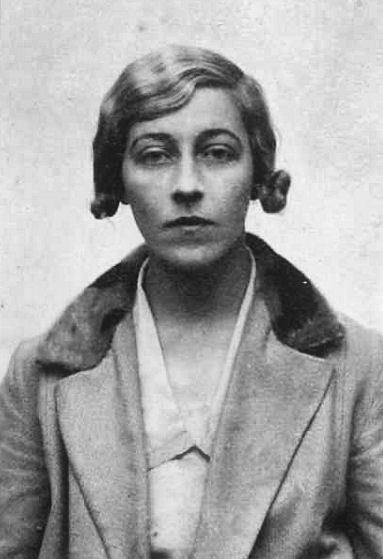 1929
1929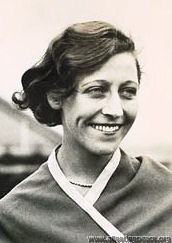
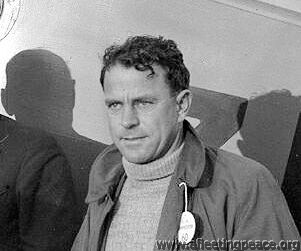
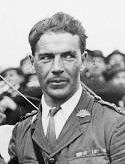
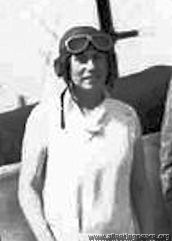 (not looking particularly chubby, imho) in 1927
(not looking particularly chubby, imho) in 1927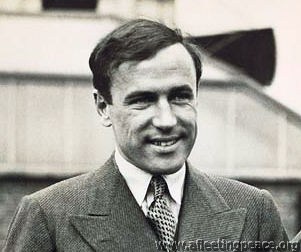
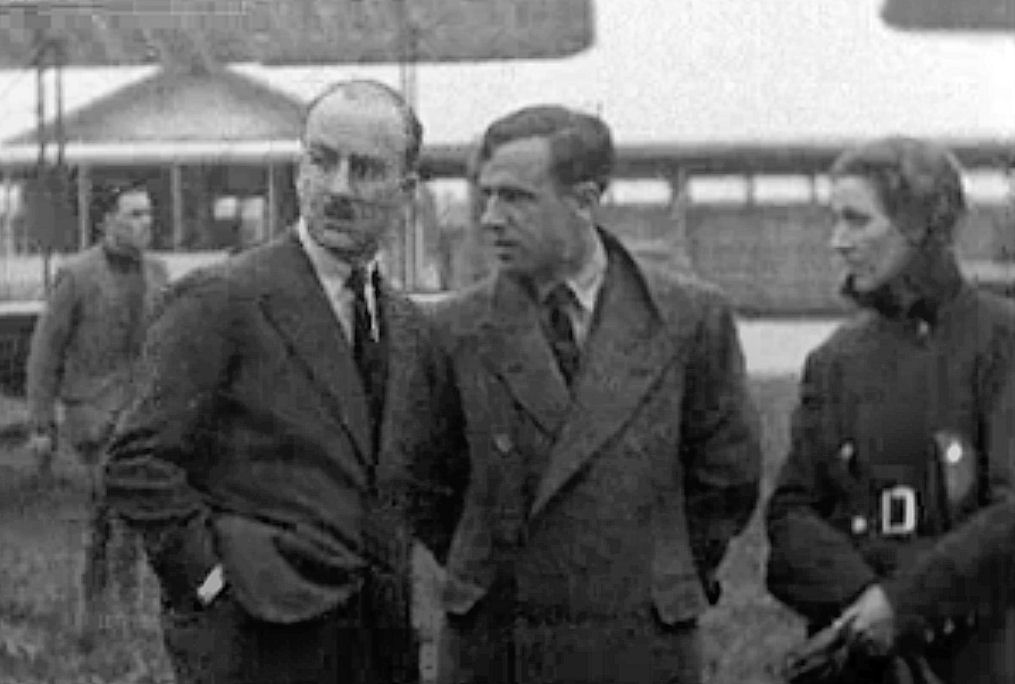
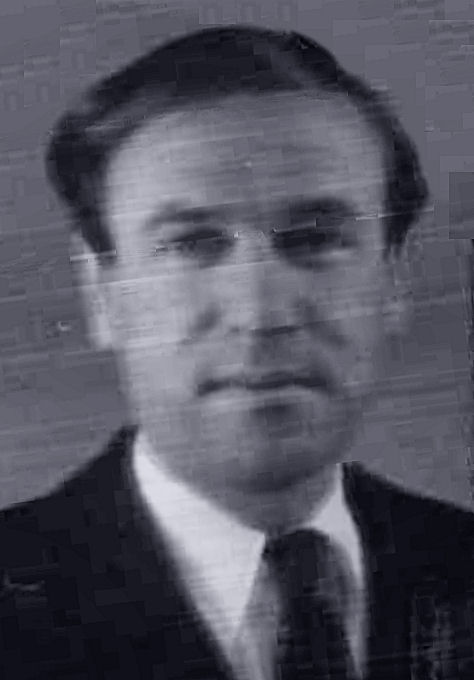 RAeC 1939
RAeC 1939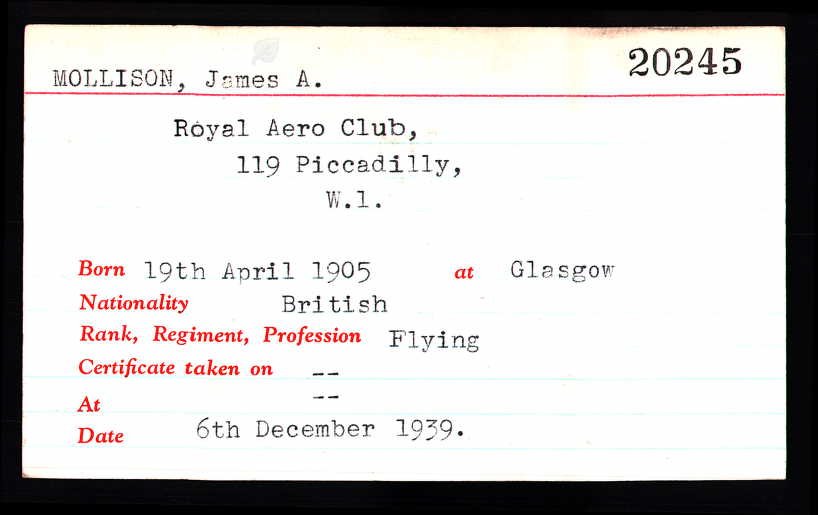
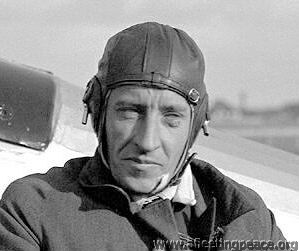
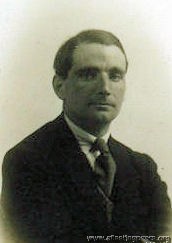 1928, aged 32
1928, aged 32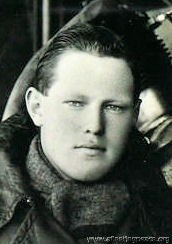
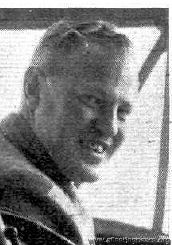
![Lankester Parker and Harold Piper [0122-0101]](/images/gallery/aviators/preview/333s333/Lankester%20Parker%20and%20Harold%20Piper%20%5B0122-0101%5D.jpg) (r), with Lankester Parker. © The Royal Aero Club
(r), with Lankester Parker. © The Royal Aero Club
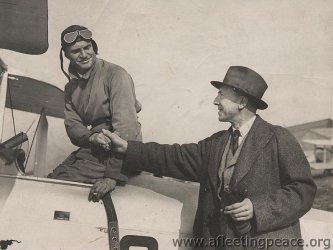 with his father Charles
with his father Charles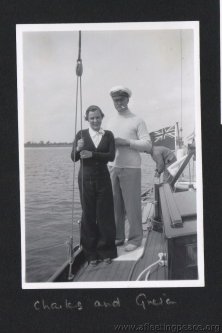
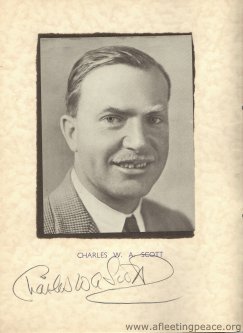
.jpg)

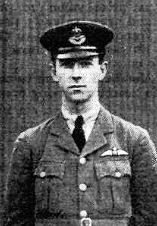
![Keith Smith [0738-0021]](/images/gallery/pioneering%20flights/preview/333s333/Keith%20Smith%20%5B0738-0021%5D.jpg)
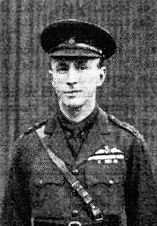
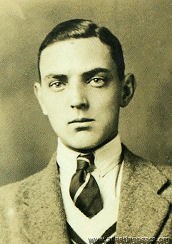 1930, aged 22
1930, aged 22